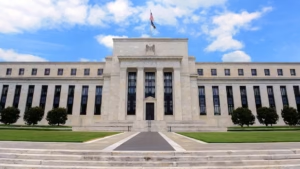Introduction
On Wednesday, the Federal Reserve decided to maintain its benchmark interest rate, reflecting a cautious stance that the central bank has adopted in recent months.

This decision comes as the Fed closely monitors the potential ramifications of President Donald Trump’s tariff policies on the economy.
By opting for a wait-and-see approach, the Federal Reserve aims to assess how these trade measures might influence economic growth, inflation, and overall market stability before making any adjustments to its monetary policy.
This careful observation underscores the central bank’s commitment to ensuring that its decisions are informed by the evolving economic landscape.
Since the Federal Reserve last modified interest rates, four meetings have taken place over a span of six months. Currently, the federal funds rate is set within the range of 4.25% to 4.5%. This rate reflects a significant increase that was implemented in response to the inflationary pressures experienced during the pandemic.
The Fed’s decision to maintain this rate indicates a cautious approach to managing economic stability, as it seeks to balance the need for growth with the ongoing challenges posed by inflation.
The Federal Reserve’s recent decision contradicted earlier statements made by former President Trump, who had labeled Federal Reserve Chair Jerome Powell as a “stupid person” and called for a reduction in interest rates.
This juxtaposition highlights the ongoing tension between political figures and economic policymakers, particularly in the context of monetary policy.
Trump’s remarks, made just hours before the Fed’s announcement, reflect a broader sentiment among some politicians who advocate for lower interest rates to stimulate economic growth.
However, the Fed’s decision suggests a commitment to its independent mandate, prioritizing economic stability and inflation control over political pressures.
This scenario underscores the complexities of navigating economic policy in a politically charged environment, where the actions of the central bank can significantly impact financial markets and public perception.
During a recent press conference, Trump expressed his frustration with the Federal Reserve’s current leadership, stating, “We have a man who just refuses to lower the Fed rate.”
He went on to suggest that he might consider taking matters into his own hands, humorously questioning whether he could appoint himself to the position.
Trump asserted that he would be more effective in managing the Federal Reserve than the current officials, implying a lack of confidence in their decision-making abilities.
The Federal Reserve’s recent approach of exercising caution has drawn significant and repeated criticism from former President Trump. Despite his vocal discontent, it is important to note that he is legally prohibited from appointing himself as the head of the Federal Reserve, which operates as an independent federal agency.
This separation of powers is designed to ensure that monetary policy remains insulated from political pressures, thereby maintaining the integrity and stability of the financial system. Trump’s critiques highlight the ongoing tension between political leadership and independent institutions, particularly in times of economic uncertainty.
Recent inflation figures released last week indicated a modest uptick in price increases; however, inflation continues to hover close to its lowest point since 2021. The labor market experienced a slowdown in hiring during May, yet the overall employment figures remained robust.
This trend suggests that the ongoing uncertainty related to fluctuating tariffs has had a less significant impact on hiring practices than some economists had anticipated, according to a government report published this month.
The Federal Reserve operates under a dual mandate that focuses on maintaining price stability and promoting maximum employment.
In principle, reducing interest rates can serve as a catalyst for enhancing economic activity and increasing job opportunities, particularly in an environment where inflation is kept in check.
By lowering borrowing costs, the Fed aims to encourage consumer spending and business investment, which can lead to a more robust labor market. This approach is especially relevant during periods of low inflation, as it allows for a more favorable economic climate conducive to growth and employment expansion.
In recent months, Powell has expressed concerns regarding the potential impact of tariffs on the economy, specifically warning that they could lead to a scenario known as stagflation.
This economic condition is characterized by a simultaneous increase in inflation rates alongside a slowdown in economic growth.
Such a situation poses significant challenges, as rising prices can erode consumer purchasing power while a sluggish economy may result in higher unemployment and reduced investment. Powell’s caution highlights the delicate balance policymakers must maintain to foster economic stability while navigating the complexities introduced by trade policies.
Stagflation presents a challenging dilemma for the central bank, particularly the Federal Reserve. In an environment where inflation is driven by tariffs, the Fed may consider increasing interest rates as a strategy to mitigate rising prices.
However, this approach carries significant risks; higher interest rates could deter borrowing, leading to a further deceleration of economic growth.
The delicate balance between curbing inflation and fostering economic activity becomes increasingly precarious, as the central bank must navigate the potential consequences of its monetary policy decisions in a complex economic landscape.
If the Federal Reserve decides to reduce interest rates in an effort to invigorate the economy amid signs of a potential downturn, it runs the risk of inadvertently increasing consumer spending, which could exacerbate inflationary pressures.
This delicate balance between stimulating growth and controlling inflation is a significant challenge for policymakers, as lower rates can lead to heightened demand for goods and services, further driving up prices.
In recent developments, former President Trump has taken steps to roll back some of his most aggressive tariffs, thereby alleviating the financial burden on importers.
These businesses often respond to increased tax obligations by raising prices for consumers, which can lead to a ripple effect throughout the economy. By reducing tariffs, the intention is to lower costs for these companies, potentially stabilizing prices and providing some relief to consumers who have been grappling with rising costs.